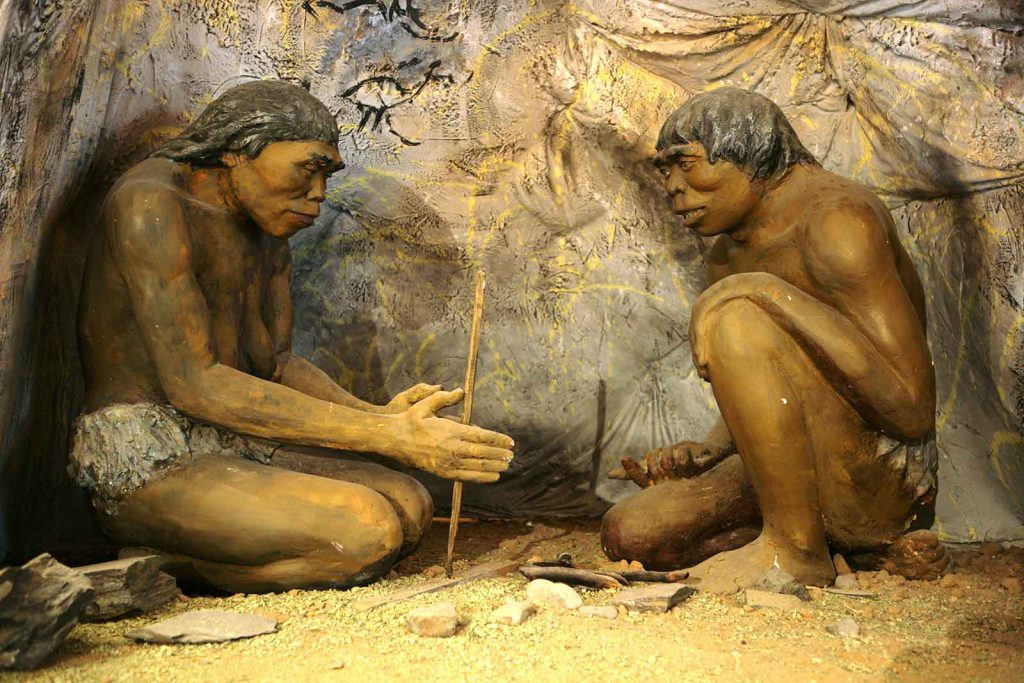Stone Age Myths We’ve Made Up
When most members of the general public think of the Stone Age, they probably envision an adult male hominin wielding a stone tool. That picture is laughably incomplete. It assumes that only adult males made and used stone tools, and that stones were the only materials in these ancient people’s everyday tool kits.
Both assumptions are at best questionable; at worst, they are simply wrong.
First, let’s tackle the stereotype about raw materials. Recent discoveries in Kenya suggest that the earliest stone tools may be as much as 3.3 million years old. Other recent discoveries in China suggest that bone tools—used, for example, to re-sharpen stone axes—may be as much as 115,000 years old. A logical inference from these studies might be that our human ancestors crafted stone tools for nearly 3 million years before making and using tools created from perishable materials such as bone.
But can it possibly be true that our primate ancestors exclusively created stone tools for more than 3 million years, 30 times longer than they made tools out of materials that break down, like bone, wood, and fiber? It’s possible, but it defies logic to think that was the case. A better explanation lies in the fact that perishable materials don’t preserve well over time, whereas stone tools remain well-preserved for eons.
That difference in preservation rates has long affected our scientific understandings of the prehistoric past—and not for the better.
In the 1830s, Danish archaeologist and curator Christian Jürgensen Thomsen defined the “three age system.” In that interpretive framework, Thomsen divided human history (as he understood it) according to the types of tools he found in archaeological sites in northern Europe. Thomsen didn’t have any absolute dating techniques available to guide his analysis (like radiocarbon or tree-ring dating); instead, he used the law of superposition—a fancy way of saying that the oldest material found in an archaeological site is, barring any disturbance, buried deepest. Think of the garbage can in your office: At the end of the week, debris from Monday will be at the bottom, debris from Wednesday in the middle, and debris from Friday at the top.
Thomsen named the oldest period in his system the Stone Age, the next oldest the Bronze Age, and the final period the Iron Age, all based on the most common tools found during each period.
Nearly 30 years later, English polymath Sir John Lubbock refined Thomsen’s categories to include the terms Paleolithic (Old Stone Age) and Neolithic (New Stone Age). For well over 150 years, Thomsen’s three age system and Lubbock’s refinements of it proved useful for organizing museum exhibits, archaeological research, and scholarly interpretations.
In applying the name Stone Age to an archaeological time period, however, the not-so-implicit assumption is that the people alive during that time only made stone tools. That unnecessarily restricts our thinking. What better term could be used for that early period? How about the First Tool Age? It may be awkward, but it’s accurate.
If an animal possesses the cognitive abilities and mechanical skills necessary to manufacture stone tools, that animal has the skills and abilities necessary to create crude tools made of other raw materials, including plant fibers, furs and skins, bone, and wood. The important skills are identifying a task that requires assistance and shaping some material to meet that need.
Many animals, including monkeys and crows, make and use tools of stone and perishable materials. The idea that our hominin ancestors didn’t do the same is simply inconceivable.
It shouldn’t surprise anyone that the oldest period in Thomsen’s three age system focuses on stone tools: They preserve the longest. What should surprise us is the odd assumption that the people who fashioned those well-preserved stone tools ignored the useful properties of other materials. It’s a logical fallacy. The absence of evidence is not evidence of absence—especially in archaeology!
Then there’s the second stereotype: Why do many people assume that only men worked with stone tools? This is simply because Western society holds dear a dominant but reductionist idea that men are hunters, women are gatherers, and the latter should tend to the home. Combine that with the fact that until recently, the vast majority of archaeologists have been men, and we end up with a situation in which women’s work, and even more so, children’s work and play, have not received proper scholarly attention. Women and children are often rendered invisible in reconstructions of past human societies.
Women tend to get credit for making ceramics and basketry, which appear in the archaeological record about 10,000 years ago. Why do women get acknowledged for these but not for stone tools? I suspect it’s because much of the labor-intensive work of ceramic and basket manufacturing is typically sedentary, thus conceptually tethering women to the home fires.
As I noted in a previous column on gender archaeology, archaeologist Margaret “Meg” Conkey once said to me, “We know that women and children existed in prehistory.” It’s a truism, but I repeat it often in conversation because it’s a useful reminder. Many people, including archaeologists, still assume that stone tools are strictly the domain of men.
Women and children are often rendered invisible in reconstructions of past human societies.
As Conkey and archaeologist Joan Gero so ably demonstrated nearly three decades ago in their edited volume Engendering Archaeology: Women and Prehistory, everyone made stone tools. Indeed, women and children today make and use stone tools all over the world, and there is no reason to believe that this is a recent phenomenon. Many stones tools are called “scrapers” because archaeologists believe they were used for scraping hides—which might be seen as women’s work, though it was performed by men or women as the need arose.
By referring to a bygone era as the “Stone Age” and failing to continuously challenge the “man-the-hunter” stereotype, the modern world does archaeology and society a disservice. Many human societies around the world don’t exhibit gender binary roles—in some Native American societies, up to five different genders are recognized, with sometimes fluid boundaries between.
Yes, there are (and probably were) general tendencies and behavioral patterns that develop along gendered lines. But I strongly suspect that if modern members of Western society look with eyes wide open, we will easily find evidence that men, women, and children—however they are defined—together did whatever it took to get the job done and to survive.
So the next time you hear of a new discovery, perhaps the “earliest” stone tool that has come to light, always think to yourself: It’s probably not actually the earliest, it’s the earliest preserved tool that we have recovered, at least to date. And when you see yet another sketch of a male hominin using a stone tool, revise that in your mind’s eye to a female and explore the logical implications of that image. In the absence of that reimagining, our human ancestors remain relegated to a far less interesting existence than they actually enjoyed.


































